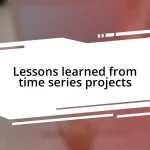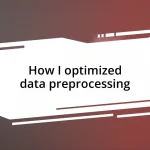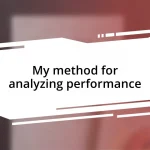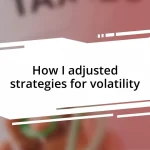Key takeaways:
- The thrill of witnessing algorithms transform parameters into trades emphasizes the importance of understanding their decision-making processes.
- Identifying market opportunities relies on a combination of technical indicators, news sentiment, historical patterns, market correlations, and volume analysis.
- Backtesting is crucial for validating strategies and learning from failures; optimization techniques enhance algorithm performance significantly.
- Implementing strict risk management strategies, such as stop-loss orders and proper position sizing, is essential for sustainable trading practices.
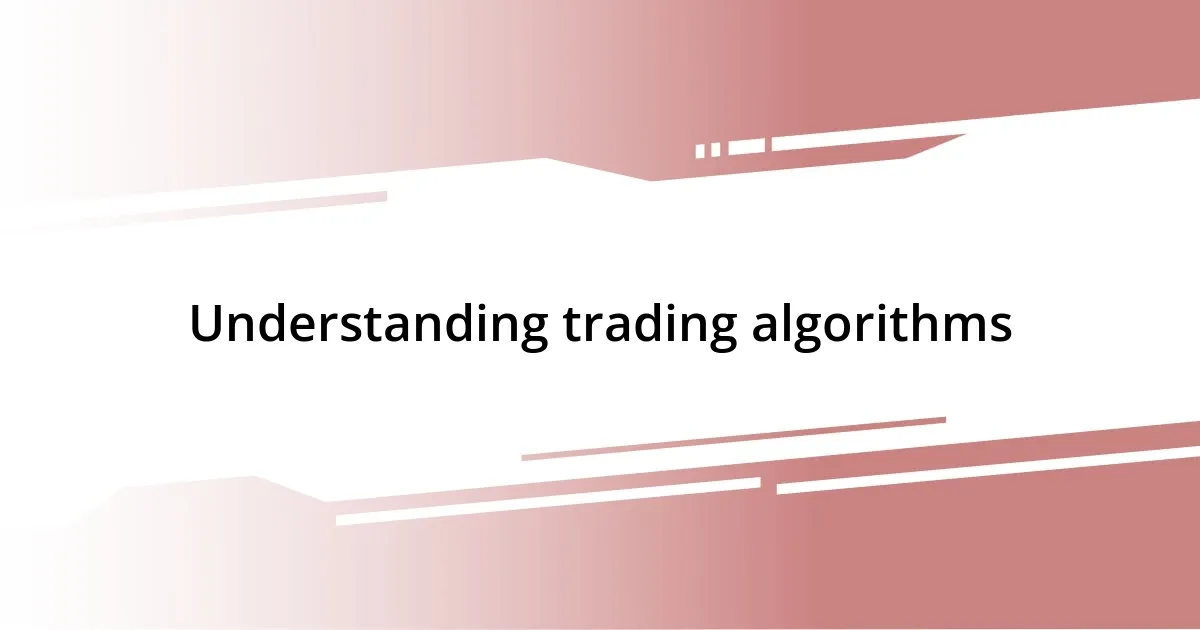
Understanding trading algorithms
Understanding trading algorithms is like peeking inside a well-oiled machine. They are essentially sets of rules and instructions that a computer follows to execute trades automatically. When I first encountered algorithms, I was fascinated by their ability to process vast amounts of data at lightning speed—something no human can do effectively.
There’s something almost exhilarating about watching an algorithm operate in real time. I remember the first time I tested my own; the thrill of seeing my parameters transform into actual trades was a mix of excitement and anxiety. How could a few lines of code have such power over the financial markets? It made me think about how crucial it is to understand not just what an algorithm does, but also the logic behind its decision-making processes.
As I delved deeper into algorithmic trading, I came to appreciate the various components that make up these systems. The blend of statistics, programming, and market psychology felt like a puzzle waiting to be solved. It wasn’t just about coding; it was about creating a strategy that reflects my trading philosophy. Have you ever wondered how traders turn their gut feelings into code? That’s the essence of algorithm development, and for me, it was like learning a new language.

Identifying market opportunities
Identifying market opportunities is the heartbeat of successful trading. Early on, I realized it wasn’t just about crunching numbers; it required a keen eye for trends and patterns. I remember sitting in front of multiple screens, feeling a rush of adrenaline as I spotted a promising signal. There’s an indescribable thrill in recognizing a potential opportunity before the crowd does—it’s like standing on the edge of a cliff, poised for a leap.
To sharpen my ability to discern these opportunities, I focused on several key aspects:
- Technical Indicators: I often relied on moving averages and RSI (Relative Strength Index) to gauge market momentum.
- News Sentiment: Using tools that aggregate news sentiment helped me understand how market mood could shift overnight.
- Historical Patterns: I found valuable insights in backtesting different strategies against historical data, unveiling trends that were otherwise invisible.
- Market Correlations: Observing the relationships between different assets helped me anticipate movements; for example, noticing how oil prices impact airline stocks.
- Volume Analysis: A sudden spike in trading volume often hinted at an impending shift, prompting me to take calculated positions.
These elements combined create a framework that increases the likelihood of recognizing an opportunity before it’s too late. It’s not just about the numbers; it’s about developing an intuition for the market, and every session nurtures that instinct further.
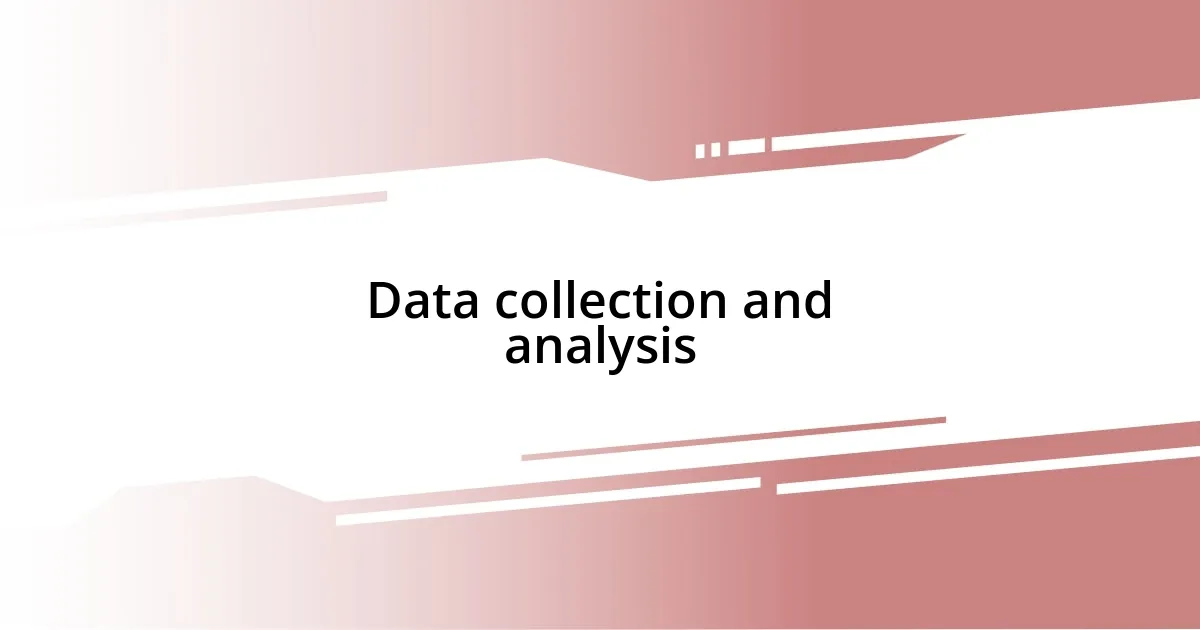
Data collection and analysis
Data collection is the cornerstone of any effective trading algorithm. In my early days of development, I remember spending hours scouring various data sources for relevant information. I often started with basic historical prices and gradually moved to more complex datasets, including trading volume and volatility metrics. Each dataset added a layer of depth to my analysis, which was not only enlightening but also quite exciting. I found that understanding market behaviors through historical data was like piecing together a captivating story; the more I collected, the better I understood the plot.
When it came to analyzing this data, I leveraged a combination of statistical methods and programming techniques. I often used Python libraries like Pandas for data manipulation, which simplified the process significantly. I can’t stress enough how crucial proper analysis is; it reveals patterns and informs decisions. There were times when I’d spot correlations between seemingly unrelated market movements. For instance, I vividly recall a moment where analyzing currency and commodity data simultaneously opened my eyes to a trading strategy I hadn’t previously considered.
Through trial and error, I learned that data collection is expansive and ever-changing. Sometimes, I would uncover insights purely by happenstance, such as when an offhand comment from a colleague led me to explore macroeconomic indicators. It’s an ever-evolving journey where curiosity fuels discovery. Engaging with the data can turn into a thrilling adventure, where one question leads to a cascade of newfound knowledge that can influence trading performance profoundly.
| Aspect | Details |
|---|---|
| Data Sources | Historical prices, trading volume, news sentiment, macroeconomic indicators |
| Tools Used | Python, Pandas, Excel, customized scripts |

Designing the algorithm framework
Designing the algorithm framework involves much more than just coding; it’s about creating a robust foundation that supports timely and informed decision-making. I vividly recall the late nights brainstorming the architecture in my mind, considering every potential edge case. Choosing the right indicators and setting their parameters felt like drafting the blueprint of a house—each decision could mean the difference between a sturdy structure and a crumbling mess.
One of the pivotal moments was when I decided to incorporate machine learning techniques for improved adaptability. Have you ever felt overwhelmed by the vast amount of data available? I certainly did! By using algorithms that learn from data, I could fine-tune my strategies based on real-time information. I remember feeling a surge of excitement when I first implemented a neural network, watching it adapt and learn from past trades. It was like witnessing a child grow; the algorithm began mastering its environment, and I could almost sense its confidence.
Finally, I understood the importance of backtesting in my framework. Seeing the algorithm perform simulations against historical data gave me clarity and conviction. It felt akin to test-driving a new car; I could assess its performance before hitting the open road. I was often amazed at how a small tweak in parameters could dramatically change the outcome, driving home the lesson that flexibility defines success in trading. It’s a constant cycle of design, test, and refine—an exhilarating journey that sharpens both the algorithm and my instincts.
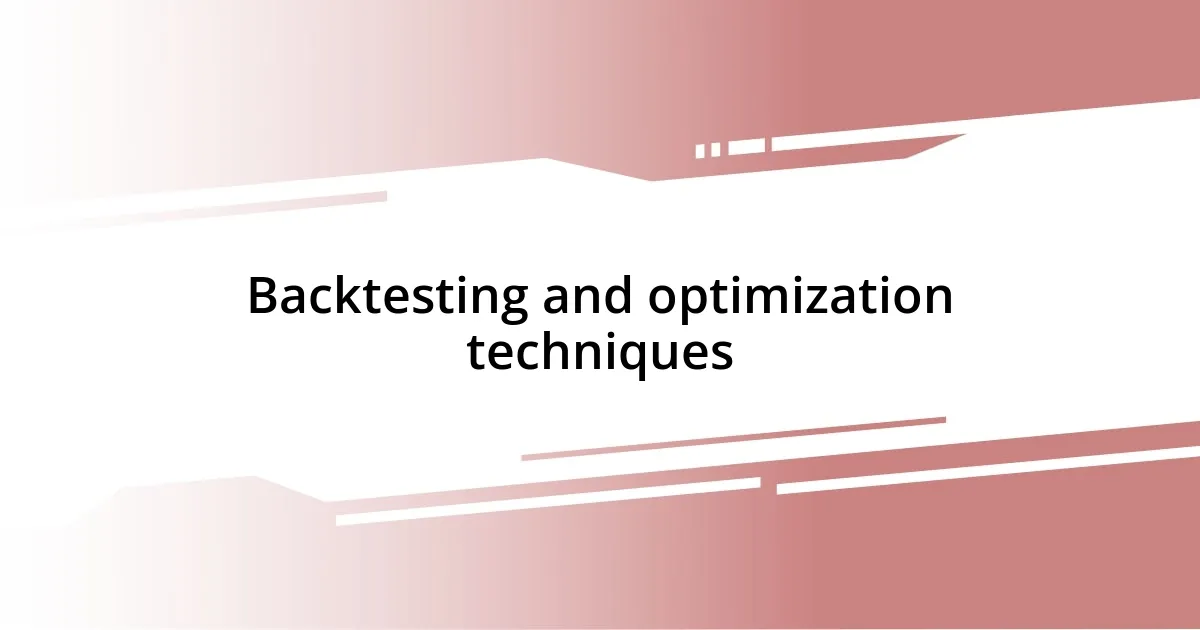
Backtesting and optimization techniques
Backtesting is one of the most crucial steps in developing a trading algorithm. I remember my first experience with it; I was both nervous and excited to see if my strategy would hold up under historical market conditions. Running multiple simulations, I often found that my intuitive decisions didn’t always fare as well as I had hoped. It’s truly humbling to realize that what you think might be a solid strategy could falter in a less-than-ideal market scenario. Have you ever been convinced of something, only to find out it wasn’t what you thought? Backtesting can be that eye-opening experience.
After being disappointed by a few initial results, I quickly learned the importance of optimization techniques. I remember diving into parameter tuning, experimenting with different settings until I struck the right balance. It felt like being a musician, adjusting the knobs on a guitar to find the perfect pitch. I often used a genetic algorithm for optimization, which mimicked natural selection by generating many variations of my trading parameters and selecting the strongest performers. This method certainly added a layer of thrill to the process, as I could witness the evolution of my strategy in real-time while gaining confidence along the way.
I can’t stress enough how iterative the process of refinement can be. Each time I fine-tuned an aspect of my algorithm, I was filled with a mix of anticipation and doubt—would this adjustment really improve performance? It was enlightening to see, in some cases, that slight modifications led to significant improvements. I distinctly remember one instance where adjusting the exit strategy resulted in a newfound ability to maximize profits on winning trades. It made me wonder: how often do we hesitate to change a small detail, only to realize its potential impact? This experimentation not only enhances the algorithm but also deepens your understanding of market dynamics, making backtesting and optimization a truly enriching part of the journey.
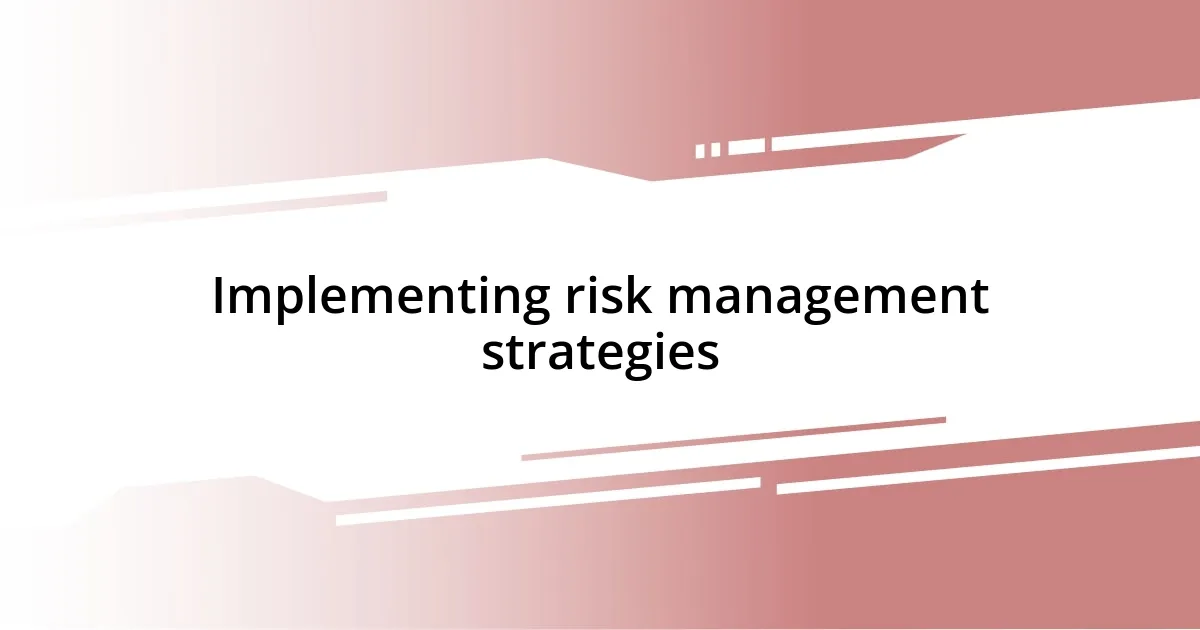
Implementing risk management strategies
Implementing risk management strategies is where the rubber really meets the road for any trader. I remember my early days; I often neglected this crucial aspect, thinking my strategies alone would carry me through the market’s ups and downs. But a few harsh lessons taught me otherwise. Have you ever felt that gut-wrenching panic when a trade doesn’t go your way? I know I have, and that’s when I truly understood the need for a safety net in trading.
One of my most impactful decisions was to set strict stop-loss orders. Initially, I resisted this idea, feeling that it would limit my potential gains. But after experiencing an unfortunate series of losing trades, I realized those stops were my best friend. My heart raced the first time I watched my stop-loss kick in just in time to mitigate a significant loss. It was like having a parachute when jumping out of a plane – a necessary precaution that saved me from free-falling into disaster.
Additionally, position sizing became an integral part of my risk management framework. I learned that no matter how confident I felt about a trade, I should never risk more than a small percentage of my account. This approach helped to create a buffer against unexpected market movements. You know that sense of calm that washes over you when you know you’re not risking it all? I experienced that firsthand, and it transformed my trading mindset profoundly. Balancing risk isn’t just about numbers; it’s about building a sustainable trading practice that no longer kept me awake at night, worrying about losses.
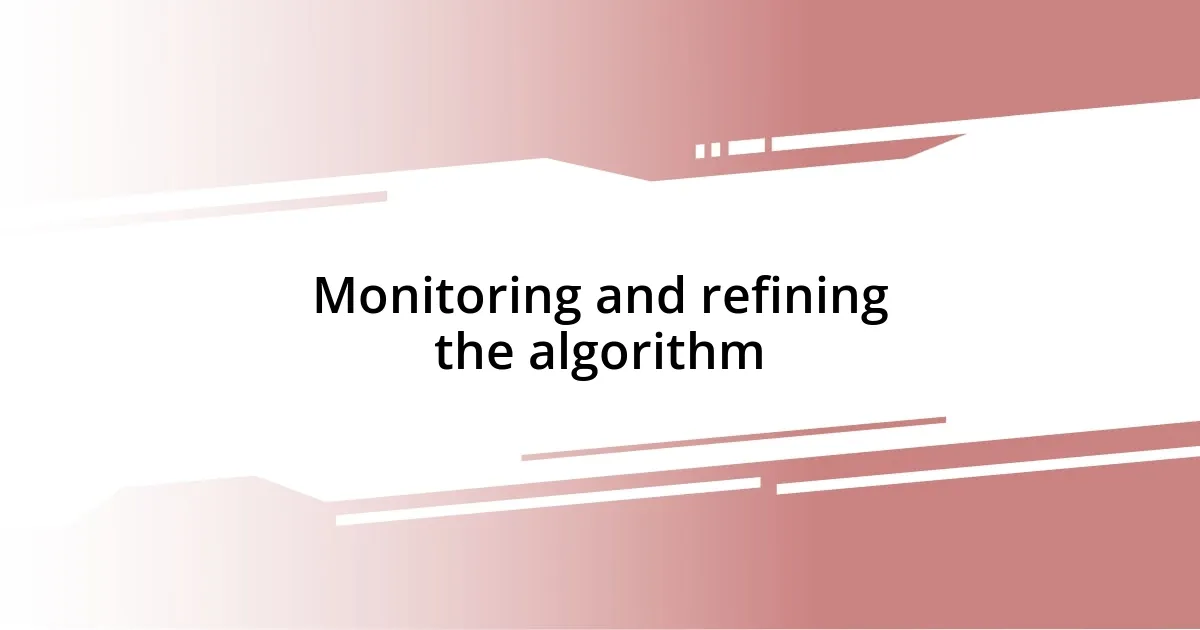
Monitoring and refining the algorithm
Monitoring my trading algorithm became an ongoing adventure, much like observing a garden grow. I found myself regularly analyzing performance metrics, looking for patterns that revealed how well my algorithm adapted to changing market conditions. One rainy afternoon, I sat down with a cup of coffee and a dataset, and I realized that certain trades weren’t just poorly timed—they highlighted a critical flaw in my strategy. Isn’t it fascinating how much insight you can gain by simply paying attention?
As I fine-tuned my algorithm, I embraced the importance of a feedback loop. I often took notes after a trading session, capturing immediate thoughts on what worked and what didn’t. This practice not only kept me grounded in my decision-making but also served as a reflective journal that I could revisit. It was during one of these reflections that I discovered the importance of adjusting parameters based on market volatility. Have you ever noticed how some strategies sparkle in calm waters but sink during storms? That realization prompted me to incorporate adaptive mechanisms that increased resilience.
The thrill of discovering new insights kept me engaged, but it also led me to the realm of continuous improvement. I recall a particular late-night coding session where I integrated machine learning techniques to allow the algorithm to evolve based on real-time data. That moment felt like a breakthrough and served as a reminder that the journey of refining my algorithm was as dynamic as the markets themselves. It made me wonder, how often do we stop at good enough instead of pushing for better? Embracing this mindset not only enhanced my algorithm’s performance but also invigorated my passion for trading.









